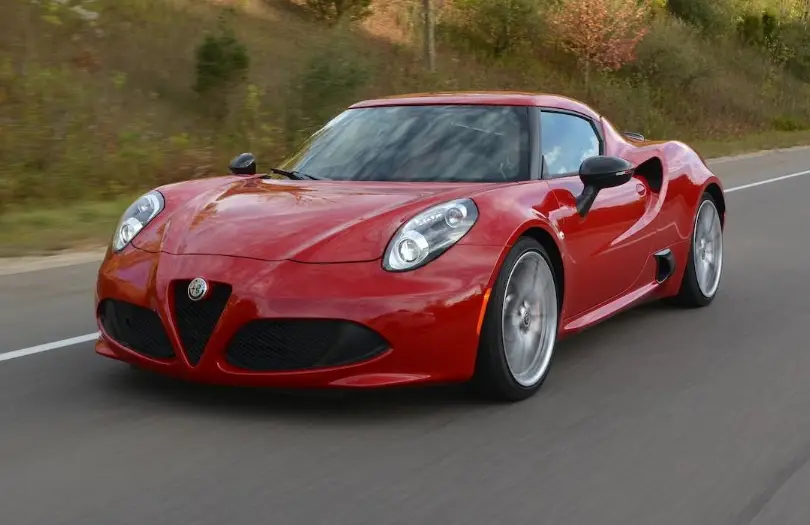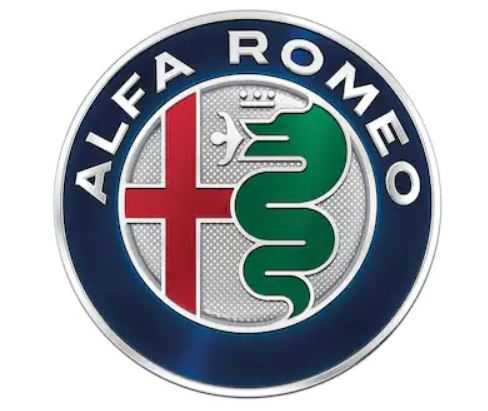2017 Alfa Romeo 4c Owner’s Manual
The 2017 Alfa Romeo 4C is an exciting and fast sports car that is a great example of Italian style and performance. The 4C is a thrilling car to drive because of how it looks, how light it is, and how powerful its engine is. It has a turbocharged 1.75-liter four-cylinder engine with a 237-horsepower output that helps it move quickly and handle well. The 4C has a carbon fiber monocoque frame, which makes it very agile and quick to respond on the road. Inside, the driver-focused cabin has modern technology, high-quality materials, and comfortable seats. Even though the 2017 Alfa Romeo 4C isn’t very practical, it gets the spirit of true sports car fans who want the thrill of the open road and a fun driving experience that will leave a lasting impression.
Instrument Panel Features

- Climate Control Air Outlets
- Multifunction Lever
- Instrument Cluster
- Washer/Wiper Lever
- Passenger Air Bag
- Switch Bank (A/C/Door Lock Switch/Door Mirror Demist-ing)
- Climate Controls
- Driver Air Bag
- Instrument Cluster Display Control Buttons
INSTRUMENT CLUSTER

- Temperature Gauge
- The temperature gauge shows the engine coolant temperature. Any reading within the normal range indicates that the engine cooling system is operat-ing satisfactorily.
- The digital gauge will likely indicate a higher temperature when driving in hot weather, or up mountain grades. It should not be allowed to exceed the upper limits of the normal operating range.
NOTE: Driving with a hot engine cooling system could damage your vehicle. The digital warning light may switch on (together with a message on the display) to indicate that the coolant temperature is too high; in this case, stop the engine and contact a dedicated authorized dealership.
WARNING! A hot engine cooling system is dangerous. You or others could be badly burned by steam or boiling coolant. You may want to call an authorized dealer for service if your vehicle overheats. If you decide to look under the hood yourself, see “Maintaining Your Vehicle.” Follow the warnings under the Cooling System Pressure Cap paragraph.
- Tachometer
- This gauge measures engine revolutions per minute (RPM x 1000). Before the pointer reaches the red area, ease up on the accelerator to prevent engine damage.
- Speedometer
- Indicates vehicle speed.
- Fuel Gauge
- The digital display shows the amount of fuel in the tank.
- The switching on of the digital warning light indicates that 1 – 1.3 gallons of fuel are left in the tank; in this situation, refuel as soon as possible. Do not travel with the fuel tank almost empty; any gaps in fuel delivery could damage the catalytic converter.
- The fuel pump symbol points to the side of the vehicle where the fuel door is located.
- “Alfa DNA” Driving Mode Indicator
- This area of the cluster displays which driving mode the vehicle is currently in. A letter (d, n, or a) corresponding to the active driving mode (dynamic or race, natural, all-weather) and a dedicated message is shown on the display.
WARNING AND INDICATOR LIGHTS
The warning/indicator lights switch on in the instrument panel together with a dedicated message and/or acoustic signal when applicable. These indications are indicative and precautionary and as such must not be considered as exhaustive and/or alternative to the information contained in the Owner’s Manual, which you are advised to read carefully in all cases. Always refer to the information in this chapter in the event of a failure indication.
All active telltales will display first if applicable. The system check menu may appear differently based upon equipment options and current vehicle status. Some telltales are optional and may not appear.
The dual brake system provides a reserve braking capacity in the event of a failure to a portion of the hydraulic system. A leak in either half of the dual brake system is indicated by the Brake Warning Light, which will turn on when the brake fluid level in the master cylinder has dropped below a specified level.
The light will remain on until the cause is corrected.
NOTE: The light may flash momentarily during sharp cornering maneuvers, which change fluid level conditions. The vehicle should have service performed, and the brake fluid level checked.
If brake failure is indicated, immediate repair is necessary.
WARNING! Driving a vehicle with the red brake light on is dangerous. Part of the brake system may have failed. It will take longer to stop the vehicle. You could have a collision. Have the vehicle checked immediately.
Vehicles equipped with the Anti-Lock Brake System (ABS) are also equipped with Electronic Brake Force Distribution (EBD). In the event of an EBD failure, the Brake Warning Light will turn on along with the ABS Light. Immediate repair to the ABS system is required.
Operation of the Brake Warning Light can be checked by placing the ignition in the MAR/ON/RUN position. The light should illuminate for approximately two seconds. The light should then turn off unless the parking brake is applied or a brake fault is detected. If the light does not illuminate, have the light inspected by an authorized dealer.
The light also will turn on when the parking brake is applied with the ignition placed in the MAR/ON/RUN position.
NOTE: This light shows only that the parking brake is applied. It does not show the degree of brake application.
CAUTION!
Do not continue driving with one or more flat tires as handling may be compromised. Stop the vehicle, avoiding sharp braking and steering. Repair immediately using the dedicated tire repair kit and contact your authorized dealership as soon as possible.
Each tire, including the spare (if provided), should be checked monthly when cold and inflated to the inflation pressure recommended by the vehicle manufacturer on the vehicle placard or tire inflation pressure label. (If your vehicle has tires of a different size than the size indicated on the vehicle placard or tire inflation pressure label, you should determine the proper tire inflation pressure for those tires.)
As an added safety feature, your vehicle has been equipped with a tire pressure monitoring system (TPMS) that illuminates a low tire pressure telltale when one or more of your tires is significantly under-inflated. Accordingly, when the low tire pressure telltale illuminates, you should stop and check your tires as soon as possible, and inflate them to the proper pressure. Driving on a significantly under-inflated tire causes the tire to overheat and can lead to tire failure.
Under-inflation also reduces fuel efficiency and tire tread life, and may affect the vehicle’s handling and stopping ability.
Please note that the TPMS is not a substitute for proper tire maintenance, and it is the driver’s responsibility to maintain correct tire pressure, even if under-inflation has not reached the level to trigger illumination of the TPMS low tire pressure telltale.
The TPMS malfunction indicator is combined with the low tire pressure telltale. When the system detects a malfunction, the telltale will flash for approximately one minute and then remain continuously illuminated. This sequence will continue upon subsequent vehicle start-ups as long as the malfunction exists. When the malfunction indicator is illuminated, the system may not be able to detect or signal low tire pressure as intended. TPMS malfunctions may occur for a variety of reasons, including the installation of replacement or alternate tires or wheels on the vehicle that prevent the TPMS from functioning properly. Always check the TPMS malfunction telltale after replacing one or more tires or wheels on your vehicle to ensure that the replacement or alternate tires and wheels allow the TPMS to continue to function properly.
NOTE: Some external parameters (eg; outdoor temperature) may affect TPMS info on your instrument cluster.
CAUTION! The TPMS has been optimized for the original equipment tires and wheels. TPMS pressures and warning have been established for the tire size equipped on your vehicle. Undesirable system op-eration or sensor damage may result when using replacement equipment that is not of the same size, type, and/or style. Aftermarket wheels can cause sensor damage. Using aftermarket tire sealants may cause the Tire Pressure Monitoring System (TPMS) sensor to become inoperable. After using an after-market tire sealant it is recommended that you take your vehicle to an authorized dealer to have your sensor function checked.
Generic Warning Indicator Light
The Generic Warning Light will illuminate if any of the following conditions occur: Oil Change Request, Engine Oil Pressure Sensor Failure, External Light Failure, Fuel Cut-Off Not Available, Parking Sensor Failure, DST System Failure.
Passenger Air Bag Indicator Light
This light should come and remain on for four to eight seconds as a bulb check when the ignition is first turned to the AVV/START or MAR/ON/RUN position. If the light stays on, or comes on while driving it may indicate a problem with a passenger airbag system, if the light flickers it may indicate an airbag warning bag failure. Have an authorized dealer service the air bag system immediately.
FAQ
A1: The 2017 Alfa Romeo 4C is a two-seater sports car, designed to accommodate two passengers.
A2: The 2017 Alfa Romeo 4C is equipped with a turbocharged 1.75-liter four-cylinder engine.
A3: The 2017 Alfa Romeo 4C delivers an impressive 237 horsepower.
A4: Yes, the 2017 Alfa Romeo 4C is available with a six-speed manual transmission for those who prefer a more engaging driving experience.
A5: Yes, the 2017 Alfa Romeo 4C is designed for use on regular roads and highways.
A6: The 2017 Alfa Romeo 4C features a lightweight carbon fiber monocoque chassis, which contributes to its agility and performance.
A7: The 2017 Alfa Romeo 4C offers exceptional handling and performance with features such as responsive steering, Brembo brakes, and a sports-tuned suspension.
A8: Yes, the 2017 Alfa Romeo 4C is available as a convertible, known as the 4C Spider.
A9: The 2017 Alfa Romeo 4C offers a driver-focused interior with supportive sports seats, a leather-wrapped steering wheel, carbon fiber accents, and a minimalist design.
A10: No, the 2017 Alfa Romeo 4C does not come with a touchscreen infotainment system. It prioritizes a lightweight and focused driving experience.
A11: The 2017 Alfa Romeo 4C is equipped with standard safety features such as antilock brakes, stability control, and airbags. However, it does not offer advanced safety technologies commonly found in mainstream vehicles.
A12: No, the 2017 Alfa Romeo 4C does not come with a backup camera as standard equipment.
A13: The available exterior color options for the 2017 Alfa Romeo 4C may vary, but common options include Rosso Alfa (red), Black, White, and Basalt Gray Metallic.
A14: The starting price of the 2017 Alfa Romeo 4C varies depending on the trim level and optional features. However, it typically started around $55,000 when new.
A15: Yes, the 2017 Alfa Romeo 4C is renowned for its exceptional performance and thrilling driving dynamics, offering an engaging and exhilarating sports car experience.
Reference Link
Download Link: https://www.alfaromeousa.com/owners/owners-service-manual
2018 Alfa Romeo 4c Owner’s Manual


